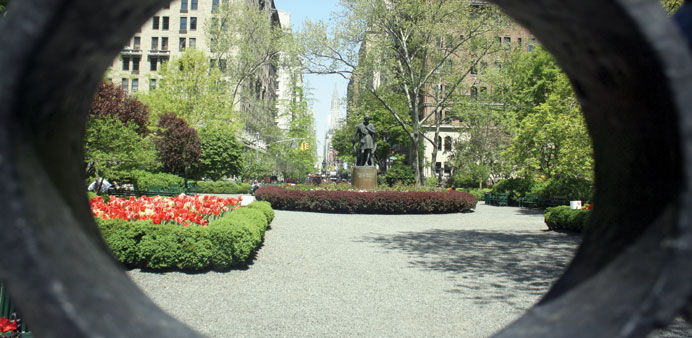By Christina Horsten
is not much to look at. Turn it in the right lock though and this security token opens your way into Gramercy Park, an exclusive world largely unnoticed by the wider public that has lain for nearly two centuries at the centre of one of the world’s most pulsating cities.
The key is a sought-after status symbol. The gated oasis is only open to residents such as fashion designer Karl Lagerfeld and actress Julia Roberts. Only 400 keys exist and owning one gives the bearer access to one of New York’s only private parks. Guests at the adjoining Gramercy Park Hotel can also stroll in the park. Count on being envied by countless New Yorkers and tourists who can only stand on the outside looking in. “The park is simply wonderful,” said Lena Koropey who was a happy key-holder for a number of years. She still lives around the corner. “It ensures that the area stays quiet and as soon I go in there I find myself uttering a sigh of relief.”
Koropey had wanted to live here ever since she was a child and saw the Woody Allen classic movie Hannah and her Sisters being filmed in the Gramercy Park neighbourhood. The haven is located in Manhattan at the lower end of Lexington Avenue between Park and Third Avenue.
The tiny district in the shadow of the Empire State Building exudes calm in one of the most bustling — and thanks to the park — most expensive areas of New York.
Famous former residents of the neighbourhood include actor John Barrymore and author John Steinbeck while former president John F Kennedy was a frequent visitor. Apart from Roberts, Uma Thurman and Rufus Wainwright live here too.
In springtime, the park is a riot of blooms in violet, yellow and pink. A perfume lingers in the air and ancient trees stand between nesting boxes for birds, a sun dial and flowerpots filled with tulips.
A 19th-century statue of actor Edwin Booth wearing a sad expression on his face takes centre-stage and a large, mobile rustles in the breeze. Only a handful of people populate the green benches and even the birds and squirrels seem to be more at ease here than in New York City’s other parks.
Eight years ago, 35-year-old Koropey trawled the Internet in search of a flat before she came across Gramercy Park. With a cheque for the security deposit in her hand, she set off to claim the apartment of her dreams. “The previous tenant was totally bowled over since he had only just uploaded the details onto the Internet. That’s how I got the place, since shortly afterwards he was bombarded with hundreds of e-mails but I had already been there.”
The park area was a watery bog until lawyer and politician Samuel Ruggles bought it up in the 1830s and had it drained.
It was declared off-limits to the general public in 1844.
Only 39 properties adjoin Gramercy Park directly and only these have rights to the keys which open the wrought-iron gates. Residents pay an admission fee of $7,500 a year and are issued with two individually numbered keys which unlock the four gates around the compound. Those who fail to pay are forced to forfeit the keys — a punishment described by ‘The New York Times’ as being so “painful that there has never been a need to impose it.”
Residents can have an extra key made — for $350 a year. Lost keys cost $1,000 each to replace and if the token goes astray again, a bill for $2,000 is incurred. Residents are allowed to bring a maximum of up to five guests with them.
The locks and keys are changed annually. After a stash of counterfeit keys turned up, security was tightened and Gramercy Park Hotel guests no longer get a key, but are escorted into the park by staff members. “When the weather is good it’s something we easily do 10 times a morning,” said one of the hotel porters.
He said he wouldn’t go to the park himself or with his family, because of the long list of forbidden activities. Visitors are not allowed to play ball, step on the lawn, take photographs, ride bicycles, keep pets, go jogging, eat or drink.
Feeding squirrels is also not allowed. The porter prefers the bustle of Central Park.
Lena Koropey moved out of her dream apartment a few years ago, although she now lives only 50m away. Her new apartment no longer lies right next to the park, so she has no park-access rights. Koropey can go to the park with friends. “I really sense what I’m missing out on,” she said ruefully. — DPA

